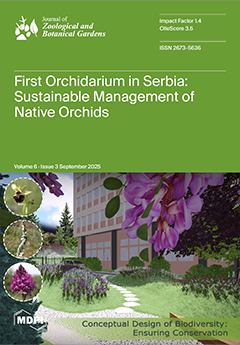Zoological environments aim to promote natural behaviours and optimal welfare conditions. Over the past decade, research on the use of artificial ultraviolet-B (UV-B) exposure has improved vitamin D
3 levels and reduced incidences of metabolic bone disease in diurnal primates; however, this has
[...] Read more.
Zoological environments aim to promote natural behaviours and optimal welfare conditions. Over the past decade, research on the use of artificial ultraviolet-B (UV-B) exposure has improved vitamin D
3 levels and reduced incidences of metabolic bone disease in diurnal primates; however, this has not been investigated in nocturnals. Aye-ayes (
Daubentonia madagascariensis), nocturnal lemurs often housed indoors in zoos with little to no exposure to natural sunlight, have been reported to have low vitamin D
3 levels. This study aims to investigate the impacts of artificial UV-B as a supplemental healthcare strategy for aye-ayes, examining its influences on vitamin D
3 levels and positional sleeping behaviour. The 25-hydroxy-vitamin D
3 (25OHD
3) blood levels were tested before and after exposure to different levels of artificial UV-B and heat sources. Statistical analysis showed no correlation between UV-B and 25OHD
3 at group parameter levels. However, one individual showed a positive correlation. Sleeping position duration analysis showed a potential basking behaviour with the use of increased ear exposure and other thermoregulatory responses. Despite representing 8.06% of the European captive aye-aye population, these findings highlight the need for further research on vitamin D
3 parameters and responses to UV-B to optimise captive conditions and support the species’ long-term health.
Full article





